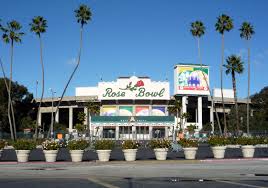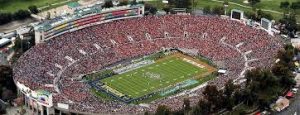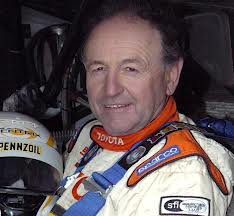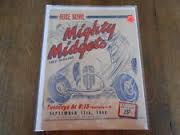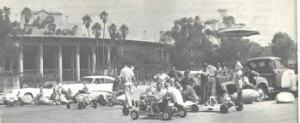Greetings from Pasadena, California
From the travels and adventures of the “World’s #1 Trackchaser”
Rose Bowl – Lifetime track #187
*
Yes, a very famous venue.
The Rose Bowl is a very famous venue. However, it has not gained its notoriety from auto racing. The stadium was designed by architect Myron Hunt in 1921. His design was influenced by the Yale Bowl in New Haven, Connecticut, which was built in 1913, opened in 1914. The Arroyo Seco was selected as the location for the stadium. Originally built as a horseshoe, the stadium was expanded several times over the years. The southern stands were completed in 1928, making the stadium a complete bowl.
The first game was a regular season contest on October 28, 1922 when Cal defeated usc 12–0. This was the only loss for USC and California finished the season undefeated. California declined the invitation to the 1923 Rose Bowl game and USC went in their place. The stadium was dedicated officially on January 1, 1923 when USC defeated Penn State 14–3.
The name of the stadium was alternatively “Tournament of Roses Stadium” or “Tournament of Roses Bowl”, until being settled as “Rose Bowl” before the 1923 Rose Bowl game. The Rose Bowl stadium is best known in the U.S. for its hosting of the Rose Bowl, traditionally being the first postseason college football game of the new year. The game is played after the Tournament of Roses Parade on New Year’s Day, or, if January 1 is a Sunday, on the following Monday January 2. The stadium’s name has given rise to the term “bowl game” for all postseason games, regardless of whether they are played in a bowl-shaped or “Bowl”-named stadium. The Rose Bowl Game is commonly referred to as “The Granddaddy of Them All” because of its stature as the oldest of all the bowl games. Since its opening, the Rose Bowl stadium has hosted the bowl game every year except the 1942 Rose Bowl, when the game was moved to Durham, North Carolina, at the campus of Duke University. Duke, which played in the game on January 1, volunteered to host the contest because of security concerns on the West Coast in the weeks following the attack on Pearl Harbor. Since 1945, the Rose Bowl has been the highest attended college football bowl game.
The Rose Bowl stadium is the only site west of the Mississippi River to host an Army-Navy game (1983). The city of Pasadena paid for the traveling expenses of the all students and supporters of both the U.S. Naval Academy and U.S. Military Academy. The attendance was 81,000. The game was brought to the Rose Bowl as there are a large number of military installations and servicemen and women, along with many retired military personnel, on the West coast.
I trackchased at the Rose Bowl in 1991.
It might surprise you to know that the Rose Bowl has had an active auto racing history as well. I went with my son Jim and friend Val Dodd to an auto race at the Rose Bowl on Saturday, March 23, 1991. The Rose Bowl was my 187th lifetime track to see. Driver Rod Millen #11 was the winner in front of a large crowd of 33,000. However, since the Rose Bowl seats more than 80,000 even an audience of more than 30,000 people might have looked small. I didn’t begin writing my famous Trackchaser Reports until about track #430. Therefore I don’t have any notes from that night at the Rose Bowl.
As I say I don’t have much recollection of the specific details of this event. It DID take place well over 20 years ago from when this post is being added. However, the Los Angeles Times helped refresh my memory. Here’s what they had to say about my 187th lifetime track visit.
Here’s what the L.A. Times had to say about this event.
Former world rally champion Rod Millen survived one of the roughest evenings in stadium racing history to win the Grand National sports truck race from the pole Saturday night in the Rose Bowl.
Millen, in a Toyota, fought off Walker Evans’ Dodge and Rob MacCachren’s Ford to win the feature event of the third round of the Mickey Thompson Off-Road Gran Prix championship series.
A crowd of 32,923 witnessed the rough-and-tumble racing in chilly weather.
Millen, who left his native New Zealand to try American racing several years ago, earned the pole by setting the fast time in qualifying and finishing fifth and fourth in the two eight-lap heats.
“I’ve never been in an off-road race that seemed so long,” Millen, who turned 40 Saturday, said. “There wasn’t a lot of room to maneuver a truck out there. Sometimes you just felt handcuffed.”
Millen became the third winner in as many races, and Toyota, the perennial manufacturers’ champion, scored its first victory. Roger Mears, who won the opening race in Anaheim, finished eighth. Evans, the San Diego winner, was second.
MacCachren finished third, equaling his career best. Ivan Stewart, last year’s series and Rose Bowl champion, was fourth and Glenn Harris, in another Dodge, fifth, followed by Roger Mears Jr.
An extremely rough and tight course was difficult for the big trucks to negotiate without getting upside down. The first heat needed four restarts and the second two before they could complete eight laps.
A series of moguls right off the starting line made the 3,000-pound pickups bounce around as if they were on pogo sticks.
“This was easily the roughest race I’ve ever run,” Stewart said. “I was like a mine field out there. You just had to pick your way through it.”
Danny Thompson agreed: “I can’t remember ever being in a rougher race than that first heat. I just got broadsided flat out.”
Harris and Evans gave Dodge a one-two finish in the first heat. Roger Mears Jr., who failed to finish the first eight-lapper when his engine expired while he was leading, held off Thompson and Evans to go wire-to-wire in the second heat.
Millen and Thompson rolled their trucks in separate accidents on the first lap of the second heat, but on the second try the field put on one of the most exiting races of the season. Thompson and Evans swapped second and third spots several times before Thompson won coming off the final turn.
Marty Coyne of Lemon Grove won the Super 1600 buggy race, with Mitch Mustard of Arvata, Colo., second. Other race winners included Sean Finley of Anaheim in Super Lites, Charles Shepherd of Bakersfield in all-terrain vehicles, Lary Noel of Antioch in UltraStock and Larry Brooks of El Cajon in the 250cc UltraCross motorcycle race.
Other racing activity at the Rose Bowl.
The Rose Bowl also played host to midget racing in the 1940s and 1950s. Back in 2010 the Daily News had this to say about midget racing at the Rose Bowl, “
The Rose Bowl hosted several midget car events in the late 1940s and early 1950s. For racing at the Rose Bowl, promoters erected a banked, wooden track. From all accounts, the promotion was successful.
At last count, I have had at least 12 people tell me – via phone calls, e-mails or in person at the supermarket – that they had seen the mighty mites on the boards at the Rose Bowl. Considering how noisy the midget racers were, it is doubtful such an event would clear civic hurdles today or avoid the environmentalists’ wrath.”
It appears go-karts have raced on Rose Bowl property as well. As far as I know there haven’t been any racing since the era of my trackchasing visit to this famous venue back in 1991.
Despite not seeing any racing at the Rose Bowl since 1991 I have made a number of return visits to this place. Carol and I have frequently been season ticket holders for UCLA football since the mid-90s. It’s a great place to watch a game.
Do you have any experience with auto racing at the Rose Bowl?
You might have remembrances about this track. If so, please feel free to share them in the comments section below. If you have any photos from back in the day, send them to me at Ranlay@yahoo.com. I’ll try to include them here.

